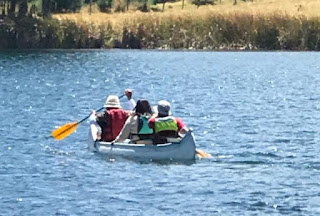Reflections with Social Scientist Rodrigo Chaparro: How Do We Think about Nature? The Impacts of Colonialism and Economic Practices
Reflections with Social Scientist Rodrigo Chaparro: How Do We Think about Nature? The Impacts of Colonialism and Economic Practices
 |
| Campesina en Tota, 2016. Photo source: Rodrigo Chaparro, in his Master thesis "Territorialidades Andinas en el Valle de Sogamoso frente a la Modernidad, la Modernización y el Desarrollismo" (Mexico, 2017) - see link. |
In our recent meeting with the social scientist Rodrigo Chaparro, we were able to discuss in greater detail socio-political mechanisms in order to gain a deeper understanding of local human practices. After growing up in Sogamoso, Chaparro studied History in Bucaramanga (Colombia), Human Geography in Michoacán (México) and is currently involved in his PhD research on Cultural Studies around Lake Tota. Through qualitative research methods (1) during the next four months, he wants to gain a deeper regional understanding of socio-political and economic dimensions in this area. Chaparro is interested in how natural resources are used, how the resource notion is configured around industry, and the frameworks and models behind them. Due to his interests in epistemology (2), he concentrates on social issues, post-colonialism, decolonialism and the application of foreign models in subaltern societies. Gaining a broad understanding by collecting different local perspectives, its origins and history of human behaviors is essential to his work. Chaparro believes that the way we interact with nature is affected by how we define it. According to that, “it is significant to include social and historical dimensions also in environmental subjects in order to interpret human reactions towards nature”, he said.
 |
| Industrial train route to Paz del Río. Photo source: Rodrigo Chaparro, 2020 |
For Chaparro, this western impact, with the impulse of the doctrine of economic development, is a sign that coloniality still persists after 200 years in Colombia. In this context, the region around the biggest lake in the country, Lake Tota, is an interesting example to obtain a closer look at the importance of industry and intentions towards the environment in an area. Furthermore, particular aspects around Lake Tota, which make up its history, its indigenous ancestry and its present peasant, form a society articulated to capitalism. Therefore, this region provides a remarkable possibility for a more critical and localized look.
Through his upcoming research, Chaparro aims to observe the detailed socio-historical and political dimensions surrounding human interactions with nature as a social construction. By addressing and reflecting frameworks, beliefs and dynamics in local societies, “we are attacking or criticising social problems and dealing more closely with history and epistemologies of capitalism in local practices. This can be painful, but it is a powerful and necessary tool to reflect on our behavior towards the environment”, he added.
In terms of finding solutions for unsustainable environmental practices, he responded that “education that takes next generations again closer to nature and teaches them non-separated concepts of environment and societies will help to conceive that humans are not above other living beings. This might help us to maintain respectfully and non-abusive practices with non-human beings”.
Rodrigo Chaparro’s opinion reminds us that matters of nature are also not able to be separated from social research projects, and that interdisciplinary and diverse views are necessary for finding answers to environmental issues. Culture and human worlds cannot be seen as divided from the environment. Moreover, questioning past and present practices are indispensable for future discussions, which are dealing with answers towards climate change and our current way of life.
--
(1)
Qualitative research methods are a type of scientific research and are
especially effective in obtaining social and cultural detailed information
about values, opinions and behaviours and provide complex textual descriptions.
Thereby interviews, participatory observation and substantive conversation are
commonly used methods. Further informations:
https://course.ccs.neu.edu/is4800sp12/resources/qualmethods.pdf
(2)
Epistemology, also known as theory of knowledge, is a philosophical study of
the origins and limits of human knowledge. Further informations:
(3)
Utilitarianism is an ethical theory, which promotes activities that maximize
happiness and a useful benefit for a majority of people. However, a profit for
the society and economy does not automatically characterize a profit also for
the environment.
*Addition:
The article aims to refer to the broader society’s viewpoint. Therefore, the
use of ‘we’ and ‘our’ was used in this text.
The
interviews were conducted in cooperation with Alexis Jenkins, Christin Meusel and
the Fundación Montecito.
This
article was written by Christin Meusel.




Comentarios
Publicar un comentario